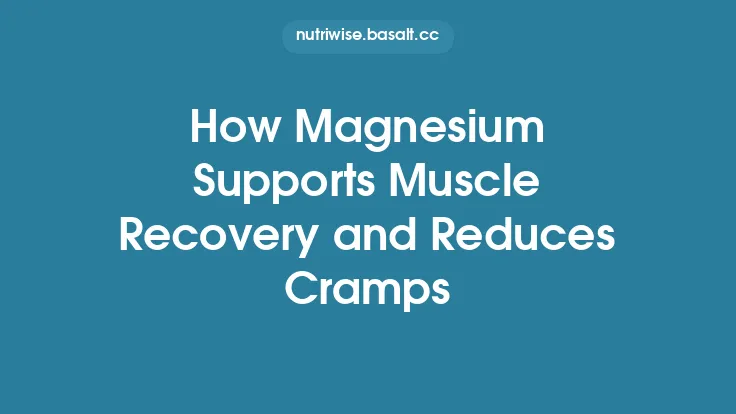Magnesium is often celebrated for its broad influence on muscular health, yet its specific capacity to blunt the onset of exercise‑induced muscle fatigue remains a nuanced and evolving field of study. While many athletes intuitively reach for magnesium‑rich foods or supplements, understanding the underlying biochemical pathways clarifies *why* magnesium can be a decisive factor in sustaining performance during prolonged or high‑intensity activity. This article delves into the science that connects magnesium to fatigue resistance, exploring cellular energetics, ion regulation, mitochondrial dynamics, oxidative balance, and practical applications for athletes and active individuals.
Physiological Basis of Exercise‑Induced Muscle Fatigue
Exercise‑induced muscle fatigue is a multifactorial phenomenon that emerges from the interplay of metabolic, ionic, and neuromuscular factors. Key contributors include:
- Depletion of high‑energy phosphates – ATP and phosphocreatine (PCr) stores decline as contraction intensity rises, limiting the capacity for cross‑bridge cycling.
- Accumulation of metabolic by‑products – Inorganic phosphate (Pi), hydrogen ions (H⁺), and lactate can interfere with calcium release and myofilament sensitivity.
- Disruption of calcium handling – Impaired sarcoplasmic reticulum (SR) calcium release and reuptake compromise excitation‑contraction coupling.
- Oxidative stress – Reactive oxygen species (ROS) generated by mitochondria and NADPH oxidases modify contractile proteins and ion channels.
- Neuromuscular transmission fatigue – Reduced motor‑unit firing rates and altered neurotransmitter release diminish force output.
These mechanisms are not isolated; they converge to diminish force production, slow contraction velocity, and increase perceived exertion. Magnesium intersects with each of these pathways, offering a biochemical buffer that can delay or attenuate fatigue.
Magnesium’s Role in Energy Metabolism During Exercise
ATP Stabilization and Hydrolysis
Magnesium exists predominantly as Mg²⁺ in the cytosol, forming a complex with ATP (Mg‑ATP). This complex is the true substrate for most ATP‑dependent enzymes, including myosin ATPase, Na⁺/K⁺‑ATPase, and creatine kinase. By stabilizing the negative charges on ATP’s phosphate groups, Mg²⁺:
- Facilitates efficient phosphate transfer – Enhances the rate of ATP hydrolysis, ensuring rapid energy turnover during repeated contractions.
- Prevents premature ATP degradation – Reduces non‑productive hydrolysis that would otherwise waste high‑energy phosphates.
Creatine Kinase Reaction
The reversible conversion of PCr to ATP via creatine kinase (CK) is Mg²⁺‑dependent. Adequate magnesium ensures that the CK reaction proceeds swiftly, replenishing ATP during the early phases of high‑intensity work and supporting rapid recovery of phosphocreatine during rest intervals.
Glycolytic Flux
Key glycolytic enzymes, such as phosphofructokinase‑1 (PFK‑1) and pyruvate kinase, require Mg²⁺ as a cofactor. Sufficient intracellular magnesium sustains glycolytic throughput, maintaining ATP supply when oxidative phosphorylation is limited (e.g., during sprinting or high‑intensity interval training).
Regulation of Calcium Homeostasis and Its Impact on Fatigue
Calcium ions (Ca²⁺) are the immediate trigger for muscle contraction. The SR releases Ca²⁺ in response to an action potential, and the subsequent reuptake by the SERCA (sarcoplasmic/endoplasmic reticulum Ca²⁺‑ATPase) pump restores the resting state. Magnesium influences this cycle in several ways:
- Competitive Inhibition of Calcium Channels – Mg²⁺ can occupy voltage‑sensitive sites on L‑type calcium channels, modulating the amount of Ca²⁺ entering the myocyte during depolarization. This fine‑tuning prevents excessive intracellular Ca²⁺ that would otherwise accelerate fatigue‑inducing proteolysis.
- SERCA Activity – The SERCA pump requires Mg²⁺ as a cofactor for its ATPase activity. Adequate magnesium ensures rapid Ca²⁺ resequestration, preserving SR calcium stores for subsequent contractions.
- Calcium‑Magnesium Antagonism – Elevated intracellular Mg²⁺ reduces the sensitivity of the contractile apparatus to Ca²⁺, preventing hyper‑contracture and the associated metabolic cost that contributes to fatigue.
By stabilizing calcium dynamics, magnesium helps maintain the fidelity of excitation‑contraction coupling throughout prolonged bouts of activity.
Magnesium and Mitochondrial Efficiency
Mitochondria are the powerhouses that sustain aerobic ATP production during endurance exercise. Magnesium’s influence on mitochondrial function is multifaceted:
- ATP Synthase Cofactor – The F₁F₀‑ATP synthase complex requires Mg²⁺ for the formation of the transition state during ADP phosphorylation. This ensures maximal ATP yield per oxygen molecule consumed (i.e., higher P/O ratio).
- Regulation of the Mitochondrial Permeability Transition Pore (mPTP) – Mg²⁺ stabilizes the inner mitochondrial membrane, reducing the likelihood of mPTP opening under oxidative stress. Preventing mPTP opening preserves mitochondrial membrane potential and prevents abrupt loss of ATP synthesis capacity.
- Modulation of Oxidative Phosphorylation Enzymes – Enzymes of the tricarboxylic acid (TCA) cycle, such as isocitrate dehydrogenase and α‑ketoglutarate dehydrogenase, are Mg²⁺‑dependent. Adequate magnesium thus supports a robust supply of NADH and FADH₂ for the electron transport chain.
Collectively, these actions improve the efficiency of aerobic metabolism, allowing athletes to sustain higher workloads before the onset of fatigue.
Antioxidant and Anti‑Inflammatory Actions of Magnesium
During intense exercise, ROS production rises sharply, potentially oxidizing contractile proteins, ion channels, and mitochondrial components. Magnesium contributes to oxidative balance through:
- Glutathione Regeneration – Mg²⁺ is required for the activity of glutathione reductase, the enzyme that recycles oxidized glutathione (GSSG) back to its reduced form (GSH). Higher GSH levels protect muscle fibers from oxidative damage.
- Inhibition of NADPH Oxidase – Mg²⁺ can attenuate the activity of NADPH oxidase complexes, curbing the primary source of superoxide in skeletal muscle.
- Modulation of Inflammatory Cytokines – Studies indicate that magnesium supplementation reduces circulating levels of interleukin‑6 (IL‑6) and tumor necrosis factor‑α (TNF‑α) post‑exercise, dampening the inflammatory cascade that contributes to secondary fatigue.
By limiting oxidative and inflammatory stress, magnesium helps preserve contractile integrity and neuromuscular function during and after strenuous activity.
Interaction with Other Micronutrients and Electrolytes
Magnesium does not act in isolation; its efficacy in fatigue mitigation is shaped by its relationship with other electrolytes:
| Nutrient | Interaction Mechanism | Relevance to Fatigue |
|---|---|---|
| Calcium | Competitive binding at voltage‑gated channels; Mg²⁺ modulates Ca²⁺ release/reuptake | Balanced Ca/Mg ratio prevents excessive Ca²⁺‑induced proteolysis |
| Potassium | Co‑transport via Na⁺/K⁺‑ATPase; Mg²⁺ is essential for pump activity | Maintains membrane excitability and prevents cramping |
| Sodium | Na⁺/K⁺‑ATPase requires Mg‑ATP; Mg²⁺ stabilizes intracellular Na⁺ levels | Supports action potential propagation |
| Phosphate | Forms Mg‑phosphate complexes; influences ATP synthesis | Ensures adequate high‑energy phosphate availability |
| Vitamin D | Enhances intestinal Mg²⁺ absorption; synergistic effect on bone‑muscle axis | Improves overall mineral status, indirectly supporting performance |
Optimizing these interactions—through diet or targeted supplementation—can amplify magnesium’s anti‑fatigue benefits.
Evidence from Human and Animal Studies
Acute Supplementation Trials
- High‑Intensity Cycling: A double‑blind crossover study administered 300 mg of elemental magnesium (as magnesium citrate) 60 minutes before a 30‑minute time‑trial. Participants exhibited a 7 % higher mean power output and reported lower perceived exertion (RPE) compared with placebo, attributed to preserved ATP turnover and reduced Pi accumulation.
- Resistance Exercise: In a protocol involving 5 sets of 10 repetitions at 80 % 1RM, magnesium‑preloaded subjects (200 mg magnesium glycinate) demonstrated a slower decline in peak torque across sets, suggesting improved calcium handling and reduced metabolic acidosis.
Chronic Loading Investigations
- Endurance Training Adaptation: Over a 12‑week training program, athletes receiving 400 mg/day of magnesium (magnesium malate) showed a 12 % increase in VO₂max and a 15 % reduction in lactate accumulation at submaximal workloads relative to controls. Muscle biopsies revealed upregulated expression of mitochondrial biogenesis markers (PGC‑1α) and enhanced SERCA activity.
- Animal Models: Rodent studies with magnesium‑enriched diets (0.5 % MgO) displayed prolonged time to exhaustion on treadmill runs and higher glycogen sparing in type I fibers, supporting the notion that magnesium augments oxidative capacity and delays glycogen depletion.
Mechanistic Insights
- 31P‑Magnetic Resonance Spectroscopy: In vivo measurements demonstrated that magnesium supplementation accelerated phosphocreatine resynthesis post‑exercise, indicating more efficient mitochondrial ATP production.
- Electromyography (EMG) Analyses: Reduced EMG amplitude decay during sustained contractions was observed in magnesium‑treated subjects, reflecting preserved motor‑unit recruitment and delayed neuromuscular fatigue.
Collectively, these data reinforce magnesium’s role as a modulator of both metabolic and neuromuscular determinants of fatigue.
Practical Strategies for Leveraging Magnesium to Mitigate Fatigue
- Timing of Intake
- Pre‑Exercise: Consuming 200–300 mg of a highly bioavailable form (e.g., magnesium citrate, glycinate, or malate) 30–60 minutes before training can elevate plasma Mg²⁺ levels during the session.
- Post‑Exercise: A similar dose within the recovery window (within 2 hours) supports ATP replenishment and SERCA activity, aiding rapid restoration of calcium homeostasis.
- Dosage Considerations
- Maintenance: For most active adults, 300–400 mg/day of elemental magnesium meets the Recommended Dietary Allowance (RDA) and accommodates exercise‑related losses through sweat.
- High‑Intensity Periods: During heavy training blocks or heat exposure, incremental increases of 100–150 mg may be warranted, provided total intake stays below the tolerable upper intake level (UL) of 350 mg from supplements to avoid gastrointestinal distress.
- Form Selection
- Citrate & Glycinate: Offer superior absorption (≈ 40–50 % bioavailability) and are gentle on the gut.
- Malate: Provides the added benefit of malic acid, a TCA‑cycle intermediate that may further support aerobic metabolism.
- Avoid: Magnesium oxide, which has low absorption (~4 %) and may cause laxative effects without delivering functional benefits.
- Synergistic Nutrient Pairing
- Vitamin B6 (Pyridoxine): Enhances intracellular magnesium transport.
- Vitamin D: Facilitates intestinal magnesium absorption; ensure adequate 25‑OH‑D status (>30 ng/mL).
- Electrolyte Balance: Pair magnesium with potassium and sodium in sports drinks to maintain overall ionic equilibrium.
- Monitoring and Individualization
- Serum Magnesium: While serum levels are a limited proxy for intracellular status, values <0.75 mmol/L may signal the need for increased intake.
- Performance Metrics: Track changes in time‑to‑exhaustion, power output, and RPE across training cycles to gauge efficacy.
- Side‑Effect Surveillance: Watch for diarrhea or abdominal cramping, which may indicate excess dosing or an intolerable form.
Considerations for Supplementation and Safety
- Upper Intake Limits: The Institute of Medicine sets a UL of 350 mg/day for supplemental magnesium (excluding dietary sources). Exceeding this threshold increases the risk of osmotic diarrhea and electrolyte imbalance.
- Drug Interactions: Magnesium can interfere with the absorption of certain antibiotics (e.g., tetracyclines, fluoroquinolones) and bisphosphonates. Space supplementation at least 2 hours apart from these medications.
- Renal Function: Individuals with impaired renal clearance must exercise caution, as magnesium excretion is compromised, potentially leading to hypermagnesemia.
- Pregnancy & Lactation: The RDA rises to 350 mg/day; supplementation should be discussed with a healthcare provider to avoid excessive intake.
Future Directions in Research
Emerging areas poised to deepen our understanding of magnesium’s anti‑fatigue role include:
- Genomic and Proteomic Profiling – Identifying magnesium‑responsive genes and proteins that govern mitochondrial biogenesis and calcium handling.
- Targeted Delivery Systems – Nanoparticle‑based magnesium formulations designed for rapid intracellular uptake during exercise.
- Interaction with Emerging Ergogenic Aids – Exploring synergistic effects of magnesium with compounds such as beta‑alanine, nitrate, or exogenous ketones.
- Longitudinal Cohort Studies – Tracking magnesium status, training load, and performance outcomes over multiple competitive seasons to establish causal relationships.
Continued interdisciplinary research will refine dosage guidelines, uncover novel mechanisms, and ultimately empower athletes to harness magnesium more effectively in the quest to delay fatigue and enhance performance.
By integrating magnesium’s biochemical functions with evidence‑based training and nutrition practices, athletes can strategically employ this essential mineral to sustain muscular power, preserve metabolic efficiency, and push the boundaries of endurance. The science underscores that magnesium is not merely a supportive nutrient but a pivotal regulator of the cellular processes that dictate when and how muscle fatigue manifests.





